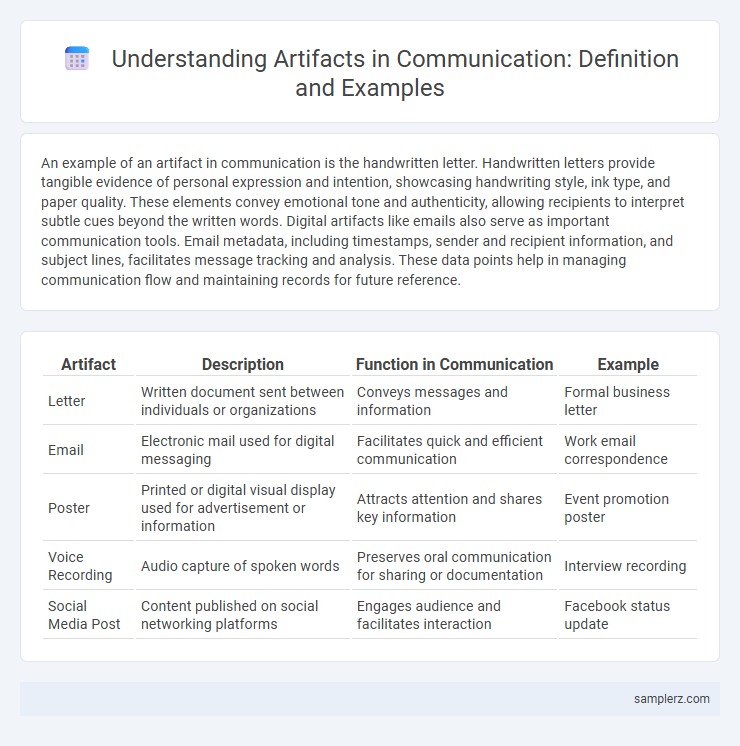An example of an artifact in communication is the handwritten letter. Handwritten letters provide tangible evidence of personal expression and intention, showcasing handwriting style, ink type, and paper quality. These elements convey emotional tone and authenticity, allowing recipients to interpret subtle cues beyond the written words. Digital artifacts like emails also serve as important communication tools. Email metadata, including timestamps, sender and recipient information, and subject lines, facilitates message tracking and analysis. These data points help in managing communication flow and maintaining records for future reference.
Table of Comparison
| Artifact | Description | Function in Communication | Example |
|---|---|---|---|
| Letter | Written document sent between individuals or organizations | Conveys messages and information | Formal business letter |
| Electronic mail used for digital messaging | Facilitates quick and efficient communication | Work email correspondence | |
| Poster | Printed or digital visual display used for advertisement or information | Attracts attention and shares key information | Event promotion poster |
| Voice Recording | Audio capture of spoken words | Preserves oral communication for sharing or documentation | Interview recording |
| Social Media Post | Content published on social networking platforms | Engages audience and facilitates interaction | Facebook status update |
Defining Artifacts in Communication
Artifacts in communication are tangible objects or visual elements that convey meaning within a cultural or social context. Examples include logos, dress codes, or office layouts that symbolize organizational values and influence interpersonal interactions. Such artifacts serve as nonverbal cues, shaping perceptions and enhancing message interpretation in various communication settings.
The Role of Artifacts in Nonverbal Communication
Artifacts such as clothing, jewelry, and accessories serve as powerful nonverbal communication tools, conveying social status, cultural identity, and personal values. These objects influence perceptions and interactions by signaling membership or distinctions within groups, often shaping first impressions without spoken words. Understanding the symbolic meanings embedded in artifacts enhances the interpretation of nonverbal cues in various communication contexts.
Cultural Significance of Artifacts
Artifacts such as traditional clothing, religious symbols, and ancient manuscripts serve as powerful communication tools that convey cultural values and social norms across generations. These objects encapsulate collective identity and historical experiences, facilitating intercultural understanding and preserving intangible heritage. Their presence in rituals, storytelling, and everyday life highlights the deep-rooted cultural significance embedded in material expressions.
Artifacts as Symbols in Interpersonal Communication
Artifacts in interpersonal communication serve as powerful symbols that convey identity, status, and cultural values without spoken words. Examples include clothing, jewelry, and personal accessories, which nonverbally express individual personality or group affiliation. These artifacts influence perception and interaction dynamics by providing contextual cues in social settings.
Technological Artifacts and Modern Communication
Technological artifacts such as smartphones, social media platforms, and video conferencing tools revolutionize modern communication by enabling instant connectivity across global networks. These devices and applications facilitate real-time interaction, multimedia sharing, and remote collaboration, significantly enhancing both personal and professional communication channels. Innovations like 5G technology and cloud-based communication systems further optimize data transmission, ensuring seamless and efficient information exchange.
Clothing and Accessories as Communicative Artifacts
Clothing and accessories serve as powerful communicative artifacts by conveying social status, cultural identity, and personal values without spoken words. For instance, uniforms instantly signal professional roles, while branded accessories often represent lifestyle choices or group affiliations. These visual cues facilitate nonverbal communication, enabling individuals to express belonging or differentiation within various social contexts.
Personal Spaces: Decor and Identity Communication
Personal spaces in communication often include artifacts like wall art, photographs, and furniture arrangements that convey individual identity and social status. These elements serve as nonverbal cues reflecting cultural values, personality traits, and relationship dynamics within both private and professional environments. Customized decor enhances interpersonal interactions by signaling belongingness and personal narratives without spoken words.
Artifacts in Workplace Communication
Artifacts in workplace communication include physical objects like name tags, office layout, and branded stationery that convey organizational culture and hierarchy. These artifacts influence interactions by subtly signaling roles, status, and company values, thereby shaping employee behavior and communication patterns. Understanding these tangible elements helps improve clarity, collaboration, and the overall effectiveness of workplace communication.
Religious and Ritual Artifacts in Social Interactions
Religious and ritual artifacts such as prayer beads, sacred texts, and ceremonial masks play a crucial role in communication by embodying cultural values and spiritual meanings within social interactions. These artifacts facilitate nonverbal communication among community members, reinforcing shared beliefs and collective identity during religious ceremonies and rites. Their symbolic significance enhances understanding and emotional connection, making them essential tools in the transmission of tradition and social cohesion.
Interpreting Artifacts Across Different Contexts
Artifacts in communication, such as symbols, gestures, or objects, carry meanings that vary significantly across cultural, social, and situational contexts, influencing message interpretation. For instance, the thumbs-up gesture is positive in many Western cultures but offensive in parts of the Middle East, highlighting the need for contextual awareness. Understanding these diverse interpretations of artifacts enhances effective cross-cultural communication and minimizes misunderstandings.

example of artifact in communication Infographic
 samplerz.com
samplerz.com